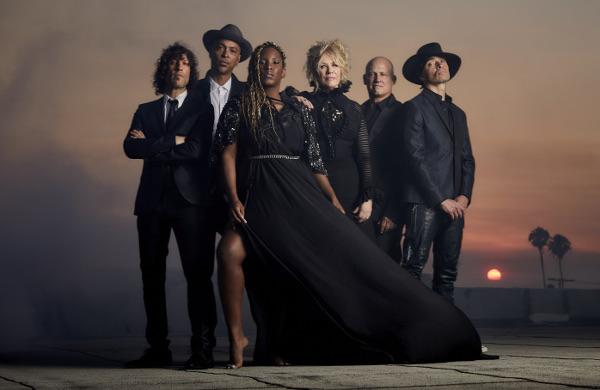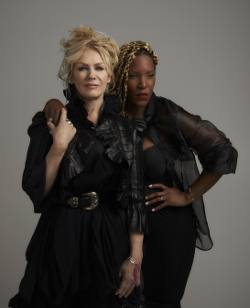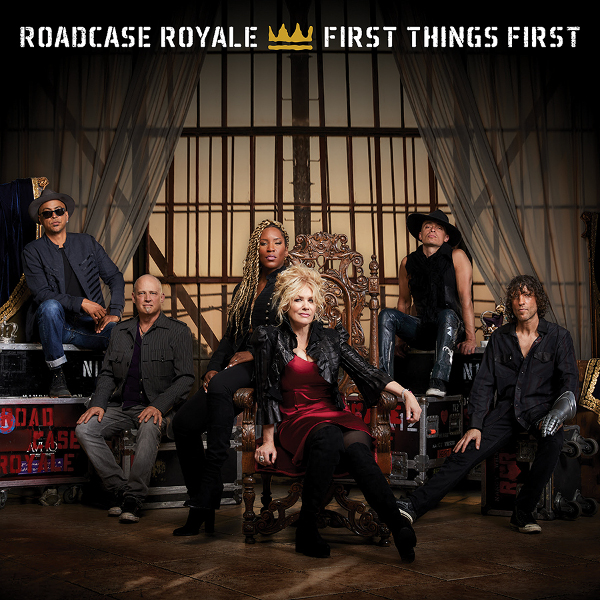Nancy Wilson Gets to the Aural Heart of Roadcase Royale’s ‘First Things First’

Nancy Wilson doesn’t like being idle. The noted Northwest-bred guitarist/vocalist was up for tackling new challenges while Heart, the band she and her sister Ann Wilson made famous, decided to take an extended break — and she found exactly what she was looking for with her new six-piece collective, Roadcase Royale.
“As a band, we’re very democratic — everybody writes, everybody contributes, everybody votes,” says Wilson about the shared energy behind RR’s propulsive debut album, First Things First (Loud & Proud Records). The proof is deep in the groove, from the pure headrush of lead single “Get Loud” to the crackling push-pull addiction lament of “The Dragon” — not to mention of-the-moment updates of a pair of Heart classics: the slide-guitar turnaround of “These Dreams” and a funkified reading of “Even It Up.”
Wilson’s chief RR foil is powerhouse vocalist Liv Warfield, the onetime singer with Prince’s New Power Generation who also appeared on the late Purple One’s 2009 release, Lotusflow3r. “I like bringing elements of soul into the rock part of what I’m singing, plus making sure there’s a certain level of angst in there too,” explains Warfield (third from the left in the above band photo, standing next to Wilson). “I also love rock guitar and those big power chords, so I’m really glad how Nancy and I get along so well in this band. It’s a really incredible link-up and match, so I have to believe it was by divine intervention.” (Can I get an “Amen”?)
I got on the line with Wilson, 63, to discuss how the band’s two guitarists mastered the album’s stereo soundfield, how she figured out the right harmony blends with her new vocal partner, and why she feels the Roadcase Royale take on “These Dreams” is the best version of that chart-topping song. While you’re still alive, you’ve gotta kick it out. . .
Mike Mettler: Looking at the way the two Roadcase Royale guitarists come across visually, you’re at stage right — or left, for audience members — and Ryan [Waters] is on the opposite side. Did you guys map out the stereo field on the record to match that? Did you say, “I need to be over here, and you need to be over there”?
Nancy Wilson: We naturally fell together that way, so we similarly mixed the album that way, just so the soundstage would match the live setting. And because Dan [Rothchild], the bass player, needs to stand closer to Ben [Smith], the drummer, Ryan and I are the stereo guitar players. We also played almost everything live at the same time in the studio.
When I was playing acoustic guitar, obviously, I would be in a different room. Ben, Dan, and Chris [Joyner, RR keyboardist] were all in the same room. If I was playing electric, then I was in the same room with them — and that’s when we’d really play off each other.
Mettler: I can really hear that vibe during the second half of “Insaniac,” where you’ve got that major power riffage going on and the whole band just totally goes for it there together.
Wilson: (chuckles) Yeah! A couple of times when Ryan has played that one live, I thought his guitar was going to explode. He’s a monster of a player. He doesn’t overplay. He knows when to be subtle, but then he really pulls out the stops for when it means something. I have endless admiration in working with Ryan right now.
Mettler: Since you’ve sung with your sister Ann in Heart for so many years, you probably have some intuitive sense about how to do harmonies. Did you have to change anything mentally when you and Liv started singing together? How did you two work that out?
Wilson: Well, harmony singing is one of my all-time favorite things to do. And singing with Ann Wilson — first, it’s a sisterly blend. It’s also second nature as to how the phrasing is going to go, what intervals are going to sound better, and what the rhythm movement should be.
It’s a really interesting thing for me to sing harmony with Liv, because she has a whole other way of phrasing. A lot of times, she’ll just throw the last syllable out, to where she almost doesn’t even sing the last syllable. I really like following her stylings, and the way she forms her sentences. Following her form is a really fun thing to do.
 Mettler: So if there’s a multisyllabic word at the end of a line, Liv will drop something like, say, the “ing”?
Mettler: So if there’s a multisyllabic word at the end of a line, Liv will drop something like, say, the “ing”?
Wilson: Yeah! For example, there’s a song on the album called “Cover Each Other,” where Liv goes (sings), “Cover each other. . .” [Wilson then lets the last syllable, the “er,” drop off silently.]
Mettler: Does that just kick in naturally live, even if you’re subconsciously conditioned to sing it another way?
Wilson: That’s exactly right! Liv does a lot of really interesting things with her phrasing that I can anticipate, now that I’m singing with her more often. Our harmonic singing has been a really cool way of learning her map, vocally.
Mettler: Having grown up in the LP era, is vinyl still a favorite way of listening to music for you?
Wilson: Yes. I have such a beautiful vinyl setup at home with great, studio-quality speakers. It’s absolutely the best way to listen to anything.
Mettler: Oh, nice. Is there a particular favorite album or albums you still like listening to on vinyl?
Wilson: We’ve listened to a lot of Joni Mitchell’s Blue (1971), Jackson Browne’s The Pretender (1976), all the Steely Dan albums — which are just so sonically exquisite — and Stevie Wonder’s Innervisions (1973).
Mettler: Much of the Heart catalog has been reissued on vinyl. That said, I think we need to have a 180-gram version of Jupiters Darling (2004), but maybe that’s just me. (Wilson chuckles) I’d also love to hear live Roadcase Royale readings of Jupiters songs like “Move On” and “Oldest Story in the World.”
Wilson: Yeah! That Jupiter album would sound so cool on vinyl, I agree. “I Need the Rain” would also be a good one to do live. There are some nice songs on there.
Mettler: On this album, I think you’ve done a great job with “The Dragon,” a song that was originally written for [the late lead vocalist of Alice in Chains] Layne Staley, after he passed away [in 2002]. Unfortunately, that song seems to apply to a lot of other people at this point, but even so, it must be satisfying to play live.
Wilson: Yeah, it is. That one was never destined to be a Heart song, even though I wrote it when Layne left us. But you’re right — these days, it applies to more people. It’s a song for people who are precariously on the edge of self-destruction. And it finally found its other part, too. I was able to put the “blue sky” piece into that song to get it finished. It was just meant to be a Roadcase Royale song.
Mettler: I like the acoustic piece you have at the beginning before you get into the Northwest crunch in the middle of it. People should be paying you royalties for bringing that element to the forefront of things, because I think you started a lot of that Seattle sound.
Wilson: (chuckles) In the ’90s, when we started meeting all the grunge guys — well, I don’t want to say “grunge,” but when that alternative music explosion was happening, we started jamming with [Alice in Chains guitarist] Jerry Cantrell at Ann’s house, and he was saying, “Show me the beginning of your song ‘Mistral Wind’ [the last track on 1978’s Dog & Butterfly].” It’s a song with all that crazy dissonance Jerry was always good at incorporating into Alice in Chains.
Mettler: It’s right there in all of that “alternative” DNA, isn’t it? I also liked how you had acoustic “intros” to many of those Heart songs from the early days — intros that would act as lead-ins to other songs that the radio stations sometimes wouldn’t play, or even the pure instrumentals like “Silver Wheels” [a short piece on 1980’s Bébé le Strange]. They were signature things that you had come up with as a recurring idea.
Wilson: I was influenced a lot by Yes, because they had a lot of those acoustic instrumental things. Those things made the albums feel more conceptual, and more musical.
Mettler: I have to say, I totally love the Roadcase Royale cover of the Colin Hay song, “Hold on to My Hand,” which I’ve had on repeat a lot.
Wilson: Oh, that’s one of the top three favorites on the album for most people too, as well as “Cover Each Other.” A lot of people like a lot of different songs, so that’s a very good sign. The album appeals to a lot of different people who love different songs, which is real exciting.

Mettler: On that track, you have a cool, Deep Purple-like organ intro before you get into the percussive part.
Wilson: Yeah! That percussive, rolling groove was something I was trying to lift out of something by [noted producer] Daniel Lanois. Daniel did a solo album called Acadie (1989), with a song on it called “Where the Hawkwind Kills.” Ours was originally called “The Hay Song” because we only heard him with the one guitar, and we made it a more “rock” thing. That groove worked really well with that one. [Colin Hay, who has long been an acclaimed solo artist, is probably best known for being the chief songwriter and lead singer in the popular ’80s Australian band, Men at Work.]
Mettler: I also like that “Never Say Die” is the last song on the record. It has a nice, bluesy stomp with those handclaps, and I feel like John Mayall’s Blues Breakers are in there too somehow, perhaps in some spiritual way.
Wilson: Oh yeah! I mean, of course, the Beano album [i.e., Mayall’s Blues Breakers With Eric Clapton album, released in July 1966] was one of my first, biggest heart-throb albums as a blues guitar player — the one with songs like “Hideaway,” and all that stuff.
Mettler: Eric Clapton really stood his ground there, because they weren’t really allowed to have distorted guitars in the studio back in 1966. But he put his foot down and said, “Nope, this is how I sound live,” and John backed him up. They were really the first artists to use distortion to that degree in the studio.
Wilson: I think that’s right. I don’t remember anything previous to it, and that album started a new, distorted standard for heavy-sounding guitar. So cool! And I always want to get a bit more distortion out of everything, as much as I can! (laughs)
Mettler: On First Things First, we also have two classic Heart covers, including the modern version of “These Dreams.” Back in the day, you fought tooth and nail to make sure that song happened. Nobody but you believed in it at the time, right? [“These Dreams,” from 1985’s self-titled Heart, featured Nancy on lead vocals, and it became Heart’s first No. 1 single during the week of March 22, 1986.]
Wilson: Yeah!! That’s true; that’s true. They were saying, “It’s going to confuse the fans, it’s not a Heart-sounding song if you’re singing lead, and do you think the fans will want that?” And I’m like (growls), “I want the sooonnngg!” (chuckles) But this new, Roadcase Royale version of “These Dreams” is my all-time favorite version of that song.
Mettler: I love the slide riffs on it. Is that you doing them, or Ryan?
Wilson: That’s Ryan. I think I said to him I thought we needed some sliding synthesizer to go with those melody parts, and he just came up with it. It’s no longer quite as ’80s-sounding, so now it has a less-dated hook to it. Liv takes the high parts in the choruses, and the harmonies are just really grand there.
Mettler: “These Dreams” still resonates. I bought that self-titled Heart album when it came out in 1985 — first on cassette, then on vinyl — and I connected with it right away.
Wilson: That’s just such a wonderful song, a melodically haunting song. And you hear it all over the place still — in grocery stores, 7-Elevens, everywhere. It’s haunted its way into people’s lives, which is nice. (chuckles)
Mettler: Your vocal on the original is very honest. Certainly, some of its raspy and delicate character could have been altered or diminished at the production stage since it’s not the typical song, as you noted. But I think it was the humanity in your voice that helped people connect with it.
Wilson: Thank you! Well, I always like to err on the side of human-ness, because that’s more real. It’s such a pretty song — and now it’s found a new life, after all this time.





























































